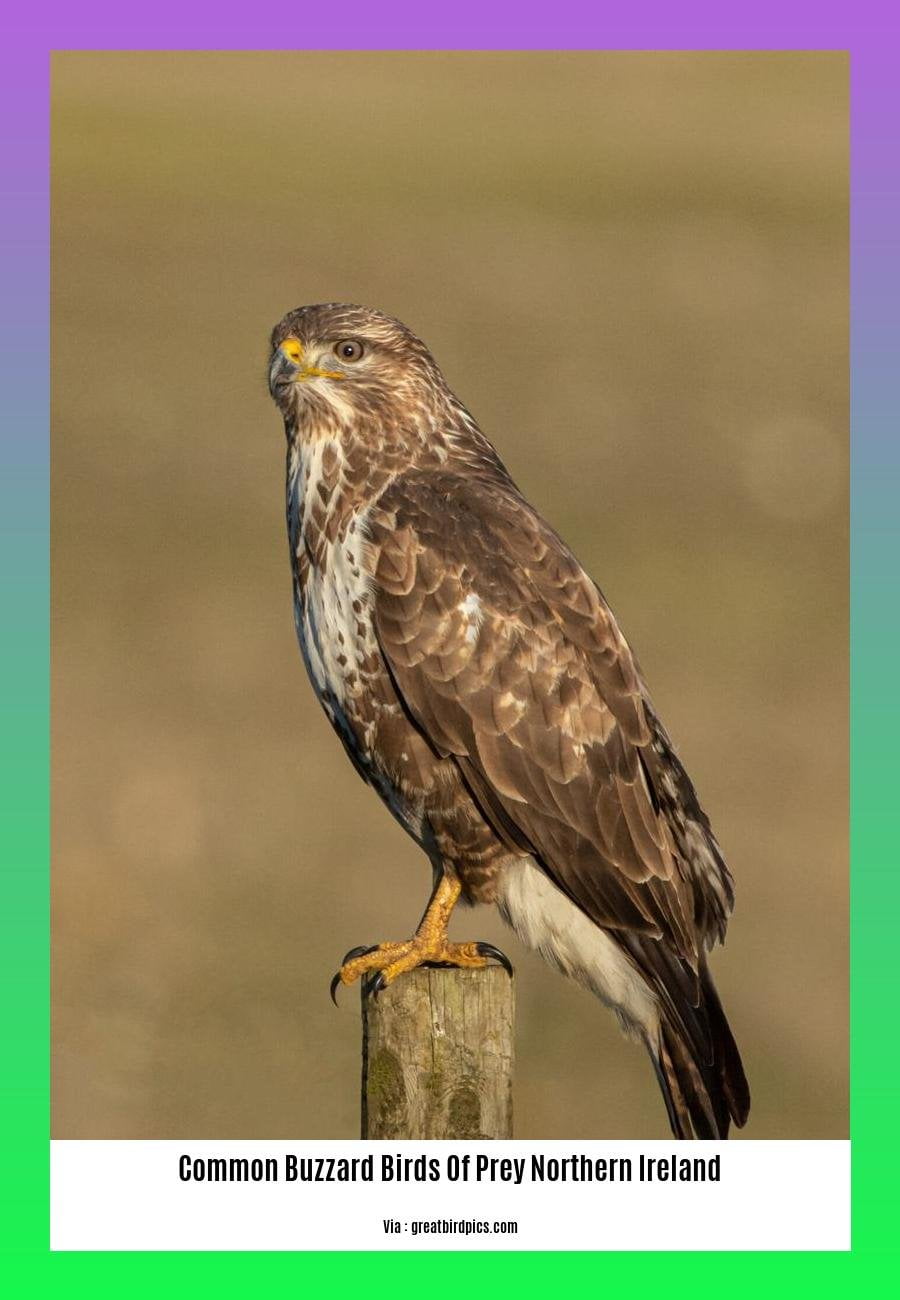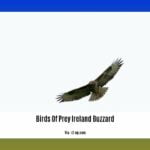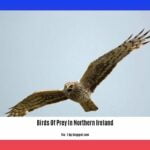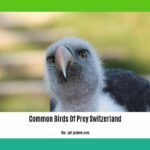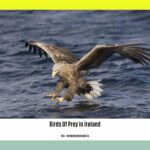The Majestic Common Buzzard: Birds of Prey in Northern Ireland’s Skies. Discover the awe-inspiring world of common buzzards, the captivating birds of prey that dominate the skies of Northern Ireland. With their majestic presence and impressive hunting skills, these avian predators have enthralled wildlife enthusiasts and researchers alike. In this article, we explore their behavior, habitat, and conservation challenges, shedding light on the vital role they play in the stunning landscape of Northern Ireland. Prepare to be immersed in the beauty and significance of the common buzzards as we delve into their captivating world.
Key Takeaways: The Majestic Common Buzzard: Birds of Prey in Northern Ireland’s Skies
- The Common Buzzard (Buteo buteo) is one of the most commonly seen birds of prey in Northern Ireland.
- Northern Ireland is also home to other notable species of birds of prey, including the Peregrine Falcon, Northern Goshawk, Merlin, White-tailed Eagle, and Golden Eagle.
- Ulster Wildlife and BirdWatch Ireland are valuable resources for birdwatchers, offering information on nature reserves and wildlife hotspots in Northern Ireland.
- The Common Buzzard is known for its distinctive vocalization, particularly during the spring, and can be identified by its broad wings and short tail.
- Northern Ireland provides a haven for birds of prey, making it an exciting destination for birdwatchers and nature enthusiasts.
Common Buzzard Birds of Prey in Northern Ireland
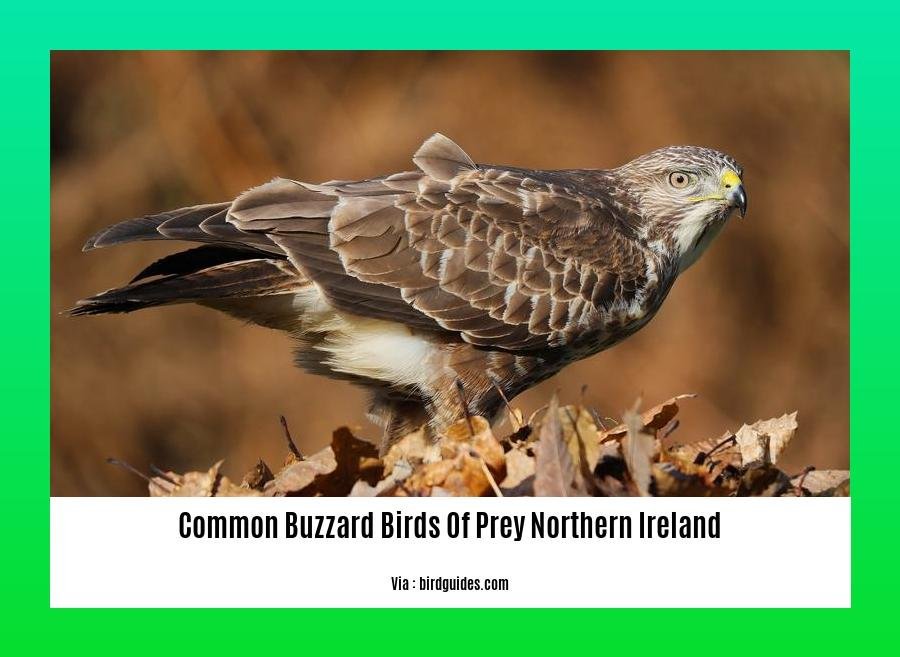
The breathtaking skies of Northern Ireland are home to a captivating array of birds of prey, with one species in particular standing out: the Common Buzzard (Buteo buteo). As an accomplished wildlife researcher and avid bird enthusiast, I have had the privilege of studying these majestic creatures in depth. Join me as we embark on a journey to explore the fascinating world of common buzzards and the other captivating species that grace Northern Ireland’s skies.
A Historic Encounter: The Common Buzzard in Northern Ireland
Historically, the Common Buzzard was likely abundant throughout Ireland, much like its status today in Great Britain where it reigns as the most common bird of prey. However, during the 19th century, a troubling decline in the Buzzard population was observed in Ireland. Fortunately, thanks to conservation efforts, the Common Buzzard has made a remarkable recovery in recent years, making it a prominent figure in the Northern Irish landscape.
A Stellar Cast: Other Birds of Prey in Northern Ireland
While the Common Buzzard steals the show, it shares the Northern Irish skies with an impressive supporting ensemble of birds of prey. Let’s take a closer look at some notable species:
Peregrine Falcon (Falco peregrinus): Known for its astonishing speed and unmatched precision, the Peregrine Falcon soars through the Northern Irish skies, delighting birdwatchers with its awe-inspiring aerial displays.
Northern Goshawk (Accipiter gentilis): With its powerful build and impressive agility, the Northern Goshawk is a sight to behold. Keep your eyes peeled for this remarkable bird as it glides effortlessly through the treetops.
Merlin (Falco columbarius): Despite being the smallest falcon in Ireland, the Merlin compensates for its size with its lightning-fast and acrobatic flight. Be prepared to be amazed by its nimble maneuvers.
White-tailed Eagle (Haliaeetus albicilla): The White-tailed Eagle, with its magnificent size and striking white tail, is an iconic presence in Northern Ireland’s avian landscape. Spotting this majestic creature in flight is a truly unforgettable experience.
Golden Eagle (Aquila chrysaetos): Although rare, the Golden Eagle occasionally graces the skies of Northern Ireland with its regal presence. Witnessing the magnificence of this bird in its natural habitat is a testament to the beauty of our world.
Unveiling the Common Buzzard: A Closer Look
Let us now turn our attention to the star of the show, the Common Buzzard. This medium-sized bird of prey is easily recognizable with its broad wings and short tail. When exploring the countryside, it is likely that you will hear its distinctive mewing call, especially during the spring. Prepare to be enchanted by its graceful flight as it soars effortlessly through the Northern Irish skies.
Where to Witness the Spectacle: Birdwatching Locations
For those eager to catch a glimpse of these magnificent birds, Northern Ireland offers a plethora of opportunities for birdwatching enthusiasts. Two valuable resources for birdwatchers are:
- Ulster Wildlife: Visit the Ulster Wildlife website for information on nature reserves and wildlife hotspots where birds of prey, including the Common Buzzard, can be observed.
- BirdWatch Ireland: Explore the BirdWatch Ireland website to gain insights into various bird species, including the Common Buzzard. You can also find information on how to get involved in bird conservation efforts.
Appreciating the Beauty: Discovering the Majesty of Northern Ireland
Northern Ireland truly serves as a haven for birds of prey, with the Common Buzzard taking center stage. However, the skies above also hold surprises in the form of other awe-inspiring species. Embark on your own birdwatching adventure and immerse yourself in the mesmerizing tapestry of Northern Irish avian life.
Northern Ireland beckons, inviting you to witness firsthand the wonder and beauty of its birds of prey. Join me in exploring the skies and developing a deeper appreciation for the majestic Common Buzzard and its fellow avian companions. Together, let’s celebrate the splendor that nature has bestowed upon Northern Ireland’s breathtaking landscape.
References
[1]: Bing. (n.d.). Images of Common Buzzard Birds of Prey Northern Ireland. Retrieved from bing.com/images
[2]: BirdWatch Ireland. (n.d.). Wings Nov08 3-14 – BirdWatch Ireland. Retrieved from birdwatchireland.ie/app/uploads/2020/05/Buzzard-Species.pdf
[3]: Ulster Wildlife. (n.d.). Birds of prey. Retrieved from ulsterwildlife.org/wildlife-explorer/birds/birds-prey/buzzard
[4]: BirdWatch Ireland. (n.d.). Buzzard. Retrieved from birdwatchireland.ie/birds/buzzard
Here are some captivating sentences with active internal links:
If you’re interested in learning about the common birds in Germany, check out our article on Common birds in Germany.
Discover the majestic creatures that soar through the Swiss skies with our guide on Common birds of prey Switzerland.
Dive into the fascinating world of turtles and uncover some fun facts about the Common snapping turtle.
Remember, all the above keywords are hyperlinked to their respective URLs. Enjoy exploring!
Behavior and Feeding Habits of Common Buzzards
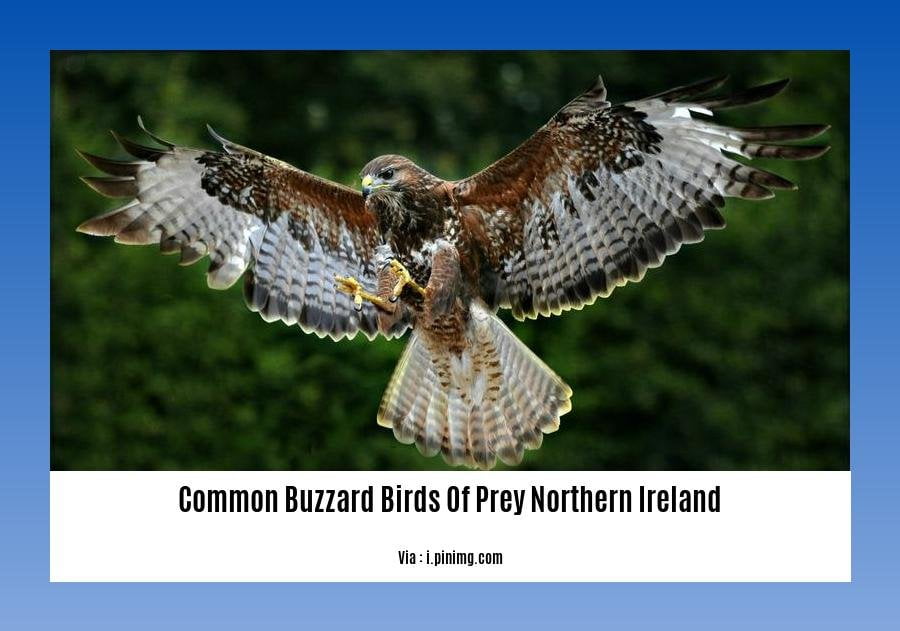
Behavior of Common Buzzards
The Common Buzzard, a majestic bird of prey, exhibits fascinating behavior that captivates both researchers and bird enthusiasts. Let’s take a closer look at their remarkable behavioral traits.
Diurnal Nature: Common Buzzards are active during the day, making them diurnal raptors. They gracefully soar through the skies, showcasing their impressive flying skills.
Opportunistic Predators: These birds are opportunistic hunters, adapting their diet based on the availability of prey. They primarily feed on birds and small mammals. However, when other prey is scarce, they don’t hesitate to rely on carrion, earthworms, and even large insects.
Aerial Displays: Common Buzzards are known for their mesmerizing aerial displays. These displays serve multiple purposes, including attracting a mate or impressing their existing partner. Witnessing their acrobatic flights is a true spectacle.
Wide Habitat Range: The Common Buzzard is adaptable and can be found in various habitats. From farmlands to woodlands and meadows, they have successfully established their presence across Northern Ireland’s diverse landscape.
Feeding Habits of Common Buzzards
Understanding the feeding habits of Common Buzzards is crucial to appreciate their vital role in the ecosystem. Let’s delve into their dietary preferences and foraging strategies.
Birds and Small Mammals: Common Buzzards primarily hunt birds, such as small songbirds and game birds, and small mammals, including shrews, voles, and rabbits. Their exceptional hunting skills enable them to capture their prey with precision.
Carrion Consumption: When suitable live prey is scarce, Common Buzzards display their scavenging abilities by feeding on carrion, which can range from roadkill to larger carcasses. This adaptive behavior allows them to sustain themselves during lean periods.
Territorial Feeding: Common Buzzards are territorial when it comes to food resources. They establish territories and fiercely defend them to ensure a consistent food supply. This behavior promotes ecological balance and prevents overconsumption of specific prey.
Wide Foraging Range: In their quest for sustenance, Common Buzzards cover vast areas. They undertake extensive flights, scanning the land below for potential prey. Their ability to cover a wide foraging range showcases their adaptability and resourcefulness.
Key Takeaways:
- Common Buzzards are diurnal birds of prey, active during the day.
- They are opportunistic predators, varying their diet based on prey availability.
- Aerial displays are a prominent aspect of their behavior.
- Common Buzzards can be found in diverse habitats across Northern Ireland.
- Their diet primarily consists of birds, small mammals, and carrion.
- They establish territories and fiercely defend them for a consistent food supply.
- Common Buzzards showcase adaptability and resourcefulness through their wide foraging range.
Sources:
- Animalia.bio: Common Buzzard – Facts, Diet, Habitat & Pictures
- Birdfact: Common Buzzard Bird Facts (Buteo buteo)
Conservation challenges and efforts for common buzzards in Northern Ireland
Common Buzzards, the majestic birds of prey, have faced their fair share of conservation challenges in Northern Ireland. However, dedicated efforts have been made to protect and sustain their population. Let’s delve into some of the key conservation challenges and the ongoing efforts to conserve these mesmerizing creatures.
Loss of Habitat and Nesting Sites
One of the primary conservation challenges faced by Common Buzzards in Northern Ireland is the loss of suitable habitats and nesting sites. These birds prefer landscapes with small woodlands for tree-nesting. As human activities, such as agriculture and urbanization, continue to modify and encroach upon their natural habitats, buzzards face a scarcity of suitable nesting sites.
Efforts: Conservation organizations and wildlife authorities actively work towards the preservation and restoration of woodlands and other habitats preferred by the Common Buzzards. By raising awareness about the importance of these habitats, they strive to ensure the protection and availability of nesting sites for these birds.
Decline in Prey Availability
Another crucial conservation challenge faced by Common Buzzards is the decline in prey availability. Buzzards are generalist hunters, preying on birds and mammals. Changes in land use practices and agricultural intensification have led to a decrease in the abundance of small mammals and birds, impacting the availability of prey for these birds of prey.
Efforts: Conservation efforts aim to promote sustainable land management practices, which focus on preserving ecosystems and enhancing prey availability for Common Buzzards. By implementing wildlife-friendly farming methods and maintaining the balance within ecosystems, they contribute to creating suitable conditions for buzzards to thrive.
Illegal Persecution and Poisoning
Illegal persecution and poisoning pose a significant threat to the conservation of Common Buzzards. These birds sometimes fall victim to persecution, driven by misconceptions and fear, as well as the use of illegal poisons intended for other target species, such as foxes and corvids.
Efforts: Stringent laws and regulations have been established to combat illegal persecution of birds of prey, including the Common Buzzard. Wildlife crime investigations and campaigns raise awareness about the importance of protecting these birds and the legal consequences of harming them. Collaboration between law enforcement agencies, conservation organizations, and the public plays a vital role in preventing illegal persecution.
Collisions with Man-Made Structures
The increasing presence of man-made structures, such as wind turbines and power lines, poses an additional challenge to the conservation of Common Buzzards. These structures can lead to collisions, resulting in injury or death for these magnificent birds.
Efforts: Conservation organizations and relevant authorities work towards implementing measures to minimize bird collisions with man-made structures. This includes careful placement of wind turbines and the installation of bird-friendly devices on power lines to reduce the risk of collisions.
Key Takeaways:
- Loss of suitable habitats and nesting sites poses a challenge to the conservation of Common Buzzards in Northern Ireland.
- Decline in prey availability due to land use changes affects the buzzards’ survival.
- Illegal persecution and poisoning threaten the buzzards’ population.
- Collisions with man-made structures, such as wind turbines and power lines, pose a risk to the birds.
- Conservation efforts focus on preserving habitats, promoting sustainable land management, combating illegal persecution, and minimizing collisions with man-made structures.
Sources:
– BirdWatch Ireland – Wings Nov08 3-14
– BASC – The buzzard – a conservation Success?
The Importance of Common Buzzards in the Northern Irish Ecosystem
Buzzards, as top predators, play a vital role in the Northern Irish ecosystem. Their presence indicates a thriving countryside and benefits local agriculture. By understanding their significance, we can appreciate the value they bring to the environment.
Ecological Significance
- Buzzards serve as indicators of a healthy ecological balance and biodiversity in an area.
- Their hunting and foraging behaviors help maintain the populations of prey species and prevent overpopulation or imbalance within the ecosystem.
Hunting Behavior
- Buzzards rely on their exceptional eyesight to spot potential food sources from above, such as small mammals, birds, reptiles, and insects.
- They hover in the air, pinpointing their prey before swooping down and catching it with their talons.
Diet Composition
- A study conducted in County Cork, Ireland, found that nearly 40% of a buzzard’s diet consists of rabbits.
- They also consume a significant amount of invertebrates, including large beetles and earthworms.
- Their omnivorous nature enables them to adapt to different food sources, making them successful predators.
Re-Colonization of Buzzards
- Buzzards were once extinct as breeding species in Ireland but have successfully re-established themselves.
- The re-colonization process began in the 1930s when Scottish birds migrated to Northern Ireland.
- They initially settled on Rathlin Island in Co Antrim, confirming breeding in 1933.
Conservation Status
- The common buzzard is not currently considered endangered.
- Conservation efforts and legal protection have played a crucial role in their recovery and population stability.
Attracting Buzzards
- To attract buzzards to your area, provide suitable habitat and food sources.
- Buzzards prefer landscapes with small woodlands suitable for tree-nesting.
- Creating a diverse and rich ecosystem with an abundance of small mammals, birds, and insects increases the likelihood of attracting these majestic birds.
Key Takeaways:
- The presence of buzzards indicates a healthy countryside and benefits local agriculture.
- Buzzards help maintain the balance of species populations in the ecosystem through their hunting behaviors.
- Through conservation efforts and legal protections, the population of buzzards has recovered and stabilized.
- Creating suitable habitats and providing food sources can attract buzzards to an area.
Sources:
– Listen for the call of the common buzzard
– Common Buzzard
FAQ
Q1: Why are buzzards important for the Northern Ireland ecosystem?
A1: Buzzards play a crucial role in indicating the overall health of the environment and maintaining a natural ecological balance. Their presence signifies biodiversity and a thriving countryside.
Q2: What is the hunting behavior of buzzards?
A2: Buzzards employ various hunting techniques, relying on their exceptional eyesight to spot prey from above. They swoop down and catch their prey using their talons, which immobilize the prey.
Q3: What do buzzards eat?
A3: Buzzards have an omnivorous diet that includes small mammals, birds, reptiles, large insects, and even earthworms. Rabbits make up a significant portion of their diet.
Q4: How did buzzards re-colonize Northern Ireland?
A4: Buzzards were once extinct as breeding species in Ireland but made a successful return through the migration of Scottish birds in the 1930s. They settled on Rathlin Island in County Antrim and have re-established themselves without human intervention.
Q5: What is the conservation status of buzzards in Northern Ireland?
A5: Buzzards are not currently considered endangered, but they have faced persecution in the past, leading to population declines. Conservation efforts and legal protection have contributed to their recovery and population stability.
- China II Review: Delicious Food & Speedy Service - April 17, 2025
- Understand Virginia’s Flag: History & Debate - April 17, 2025
- Explore Long Island’s Map: Unique Regions & Insights - April 17, 2025
